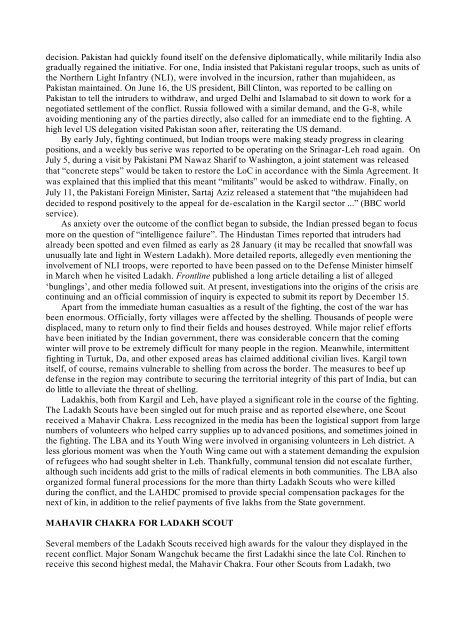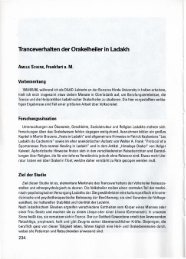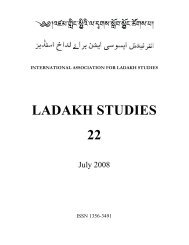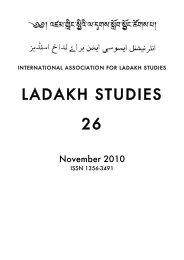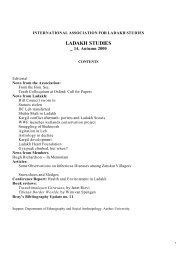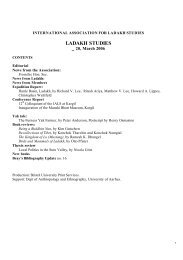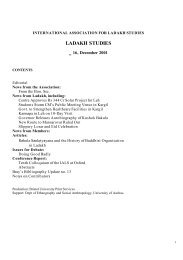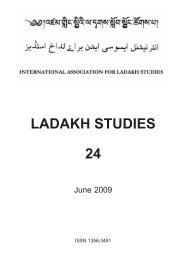LADAKH STUDIES 12, Autumn 1999 - International Association for ...
LADAKH STUDIES 12, Autumn 1999 - International Association for ...
LADAKH STUDIES 12, Autumn 1999 - International Association for ...
Create successful ePaper yourself
Turn your PDF publications into a flip-book with our unique Google optimized e-Paper software.
decision. Pakistan had quickly found itself on the defensive diplomatically, while militarily India also<br />
gradually regained the initiative. For one, India insisted that Pakistani regular troops, such as units of<br />
the Northern Light Infantry (NLI), were involved in the incursion, rather than mujahideen, as<br />
Pakistan maintained. On June 16, the US president, Bill Clinton, was reported to be calling on<br />
Pakistan to tell the intruders to withdraw, and urged Delhi and Islamabad to sit down to work <strong>for</strong> a<br />
negotiated settlement of the conflict. Russia followed with a similar demand, and the G-8, while<br />
avoiding mentioning any of the parties directly, also called <strong>for</strong> an immediate end to the fighting. A<br />
high level US delegation visited Pakistan soon after, reiterating the US demand.<br />
By early July, fighting continued, but Indian troops were making steady progress in clearing<br />
positions, and a weekly bus serive was reported to be operating on the Srinagar-Leh road again. On<br />
July 5, during a visit by Pakistani PM Nawaz Sharif to Washington, a joint statement was released<br />
that “concrete steps” would be taken to restore the LoC in accordance with the Simla Agreement. It<br />
was explained that this implied that this meant “militants” would be asked to withdraw. Finally, on<br />
July 11, the Pakistani Foreign Minister, Sartaj Aziz released a statement that “the mujahideen had<br />
decided to respond positively to the appeal <strong>for</strong> de-escalation in the Kargil sector ...” (BBC world<br />
service).<br />
As anxiety over the outcome of the conflict began to subside, the Indian pressed began to focus<br />
more on the question of “intelligence failure”. The Hindustan Times reported that intruders had<br />
already been spotted and even filmed as early as 28 January (it may be recalled that snowfall was<br />
unusually late and light in Western Ladakh). More detailed reports, allegedly even mentioning the<br />
involvement of NLI troops, were reported to have been passed on to the Defense Minister himself<br />
in March when he visited Ladakh. Frontline published a long article detailing a list of alleged<br />
‘bunglings’, and other media followed suit. At present, investigations into the origins of the crisis are<br />
continuing and an official commission of inquiry is expected to submit its report by December 15.<br />
Apart from the immediate human casualties as a result of the fighting, the cost of the war has<br />
been enormous. Officially, <strong>for</strong>ty villages were affected by the shelling. Thousands of people were<br />
displaced, many to return only to find their fields and houses destroyed. While major relief ef<strong>for</strong>ts<br />
have been initiated by the Indian government, there was considerable concern that the coming<br />
winter will prove to be extremely difficult <strong>for</strong> many people in the region. Meanwhile, intermittent<br />
fighting in Turtuk, Da, and other exposed areas has claimed additional civilian lives. Kargil town<br />
itself, of course, remains vulnerable to shelling from across the border. The measures to beef up<br />
defense in the region may contribute to securing the territorial integrity of this part of India, but can<br />
do little to alleviate the threat of shelling.<br />
Ladakhis, both from Kargil and Leh, have played a significant role in the course of the fighting.<br />
The Ladakh Scouts have been singled out <strong>for</strong> much praise and as reported elsewhere, one Scout<br />
received a Mahavir Chakra. Less recognized in the media has been the logistical support from large<br />
numbers of volunteers who helped carry supplies up to advanced positions, and sometimes joined in<br />
the fighting. The LBA and its Youth Wing were involved in organising volunteers in Leh district. A<br />
less glorious moment was when the Youth Wing came out with a statement demanding the expulsion<br />
of refugees who had sought shelter in Leh. Thankfully, communal tension did not escalate further,<br />
although such incidents add grist to the mills of radical elements in both communities. The LBA also<br />
organized <strong>for</strong>mal funeral processions <strong>for</strong> the more than thirty Ladakh Scouts who were killed<br />
during the conflict, and the LAHDC promised to provide special compensation packages <strong>for</strong> the<br />
next of kin, in addition to the relief payments of five lakhs from the State government.<br />
MAHAVIR CHAKRA FOR <strong>LADAKH</strong> SCOUT<br />
Several members of the Ladakh Scouts received high awards <strong>for</strong> the valour they displayed in the<br />
recent conflict. Major Sonam Wangchuk became the first Ladakhi since the late Col. Rinchen to<br />
receive this second highest medal, the Mahavir Chakra. Four other Scouts from Ladakh, two<br />
<strong>12</strong>


